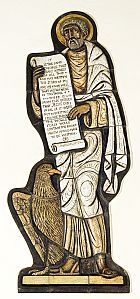GOSPEL READING

THE GOSPEL OF LUKE
Chapter 12: Overview
Chapter 12 is the last of a series of long chapters; since chapter 6 around 50 or even 60 verses has been the norm for each chapter. From chapter 13 onwards, they will be much shorter, around 35 verses. We will though discover that the final verses of this chapter 12 fit better with the beginning of chapter 13.
Read therefore through the 59 verses of chapter 12 and then continue into the next chapter. We have seen earlier how 11,54 is an ending and 12,1 a beginning. Look for the next beginning; a change of time and place is the clue.
Consider who is speaking throughout and into the following chapter. Who is addressed in most of the chapter and where is the change of audience?
Verse 15 speaks of "them", consider to whom this refers.
Note where the interruptions come and who makes them. Consider the various topics addressed. What are the various parts of the speech which result? Spot how one part of the speech is indicated by a key word; here it is quite common for a teaching of Jesus to end with a quotable saying (or "soundbite"). Another passage has its theme set by two words.
Then consider the style and development of the chapter before looking at my response.
Much of this chapter has parallels in the Gospel of Matthew but these are found in several different chapters of that Gospel. We will therefore be making only limited comparisons between the two Gospels in order to highlight specific points.
The Sunday Gospel
The first section of the chapter, 12,1-12, is not read on Sunday but most of this chapter from 12,13 onwards is read over three Sundays:
- 18th Sunday: 12,13-21
- 19th Sunday: 12,32-48
- 20th Sunday: 12,49-53
These passages do not fit neatly the development we have found; we will comment further as we go along. We can note at this stage that 12,32-34 on the 19th Sunday would have fitted better with the Gospel of the previous Sunday.
We are now ready to read the first part of the chapter, a warning against the Pharisees, 12,1-12.
